IDEX Online Research: Polished Diamond Prices Up in January; A Prelude to Higher Prices in 2010 (Full Analysis)
February 04, 10
The good news is that the recovery in diamond prices began about the same time as the U.S. economy started showing signs of real growth. Historically, diamond demand has lagged behind economic recovery by a few months; this time, however, there appears to be a much closer correlation, with a concurrent move in diamond prices and economic growth.
Further, some other diamond-consuming nations around the world have also begun to report improved economic growth.
Because of the potential for diamond demand to increase, polished diamond prices have begun to move higher. In particular, there is one over-riding factor that appears to be pushing polished diamond prices higher much sooner than expected: diamond inventory in the pipeline is particularly low at the retail level – perhaps 20-30 percent below normal. Thus, when retailers begin to re-order diamonds and diamond jewelry, there could be a lag in filling those orders.
Key Polished Diamond Prices Statistics, January 2010
· The IDEX Online Polished Diamond Price Index averaged 110.12 for the month of January.
· The IDEX Online Polished Diamond Price Index ended in January nearly two points higher at 111.45, versus its level at the beginning of the month, 109.35.
· January’s IDEX Online Polished Diamond Price Index was well above the roughly 108 that the index averaged from April through November 2009.
· The recovery in diamond prices began in December 2009, when the IDEX Online Polished Diamond Price Index was just over 109.
The graph below summarizes polished diamond price movement based on the IDEX Online Polished Diamond Price Index for the past two years.
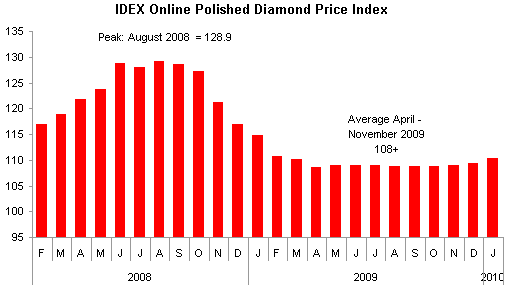 Source: IDEX Online |
Outlook: Higher Diamond Prices on the Horizon
Polished diamond prices rose by 1.9 percent in January. On an annualized basis, this would be a 22 percent gain. While that dramatic increase is not sustainable for any length of time, it illustrates the momentum that is building to push polished diamond prices higher, both near term and over the longer term.
Our advice to diamantaires: if someone offers you a deal on diamonds because they need to raise cash, now is the time to snatch up those diamonds. Prices are headed higher.
Month-to-Month Polished Diamond Prices Up 0.8% in January
 |
For the month of January 2010, global polished diamond prices rose 0.8 percent from December 2009, based on average price levels for the month. On an annualized basis, this indicates that global polished diamond prices could rise by as much as 9-10 percent during 2010, if this trend holds. While a price gain of this magnitude would be well above the long term inflation rate for polished diamonds, it is a sustainable rate during a recovery period. However, even if diamond prices rise by 10 percent during 2010, they will still end the year below the peak level in mid-2008.
Diamantaires are pushing prices up in anticipation of re-stocking at the retail level, both in the U.S. market and around the world.
The graph below illustrates month-to-month changes in global polished diamond prices, based on the IDEX Online Polished Diamond Price Index.
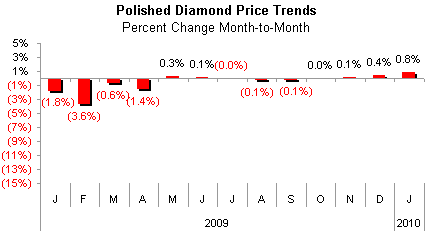 Source: IDEX Online |
Year-to-Year Global Polished Diamond Prices Show Smaller Decline in January
 |
After declining by mostly double-digit levels for the past year, polished diamond prices in January recorded the smallest drop since January 2009. For the month, the average polished diamond price was down only 4.0 percent.
It makes no sense to extrapolate future diamond prices based on the year-to-year price comparison, since we apparently have reached the inflection point in the diamond demand curve, when the direction of prices is changing from a downdraft mode to an updraft mode. Suffice it to say: diamond prices are headed higher.
The graph below illustrates the year-to-year polished diamond price trends on a monthly basis for the past 13 months.
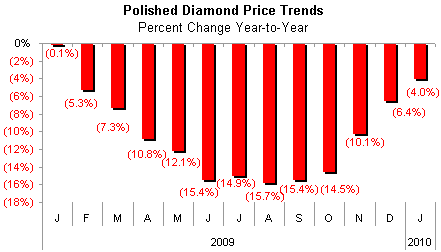 Source: IDEX Online |
Daily Polished Diamond Prices Show Sustained Increase in January
On a daily basis, polished diamond prices showed a solid, sustained upward movement during the month, as illustrated in the graph below. In part, this was due to early reports of a highly successful holiday selling season in the November-December 2009 period that was stronger than most forecasters had predicted.
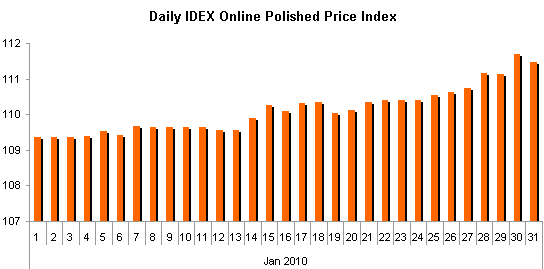 Source: IDEX Online |
Polished Price Trends Vary Significantly by Size of Gemstone
Diamonds three carats and smaller showed solid price gains in January compared to the prior month of December. Unfortunately, polished diamond prices for larger carat stones – four carats and larger – fell modestly during the month.
We believe that this price disparity between smaller stones and larger gems is due to consumers “buying down,” buying smaller stones, sometimes of lower quality, in an effort to save money.
The graph below illustrates price trends on a month-to-month basis for polished diamonds by key size.
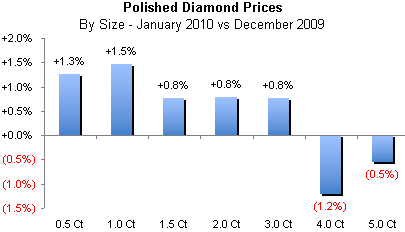 Source: IDEX Online |
The good news is that there are still plenty of buyers in the malls. The challenge is for jewelers to sell consumers better, larger diamonds.
The table below summarizes month-to-month price movement by key diamond sizes over the past three months.
 Source: IDEX Online |
The graph below illustrates polished diamond price trends for the past three years by size, based on the IDEX Online Polished Diamond Price Index. There was clearly a price bubble in mid-2008. The bubble burst late in the third quarter of 2008 as consumer demand waned; diamond prices fell and financing in the diamond pipeline dried up. We believe the recovery in diamond prices has begun.
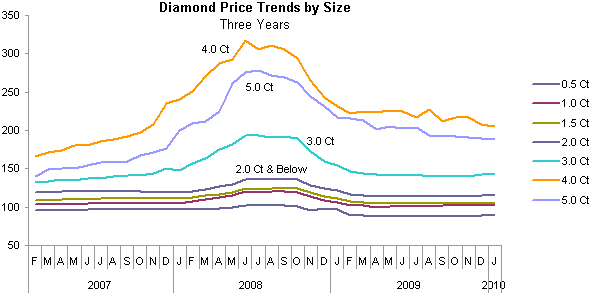 Source: IDEX Online |
Year-to-Year Diamond Price Declines Slowing
The table below summarizes the year-to-year price trends for polished diamonds by size over the past three months. The good news is this: every size diamond among the key sizes on the table below showed a smaller year-to-year price drop in January 2010 versus the prior two months.
 Source: IDEX Online |
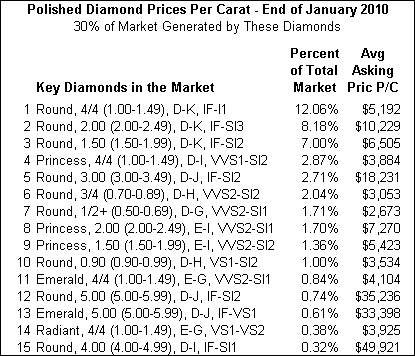 Source: IDEX Online |
The U.S. is the market to watch. In the third quarter of 2009, its economy grew by a moderate but hopeful 2.2 percent. Further, preliminary fourth quarter 2009 data was just released, and it showed a 5.7 percent increase in Gross Domestic Product (GDP), the sum of all goods and services produced in the American economy. This sharp growth points to the prospect of much stronger economic activity, both short and long term.
Since American shoppers consume roughly half of the global production of diamonds and diamond jewelry, it is important to focus on this market. For sure, there are other potential growth markets – China and India, for example. The European market is also important, but it is not a long term growth market, nor is it showing significant signs of a pickup in the various regional economies.
As the U.S. economy recovers, and as laid-off workers return to their jobs, Americans loosen their purse strings even more. As we have said on numerous occasions, the so-called Great Recession of 2007-2009 will not de-rail 50,000 years of humans’ cultural affinity for gemstones, precious metals and jewelry.